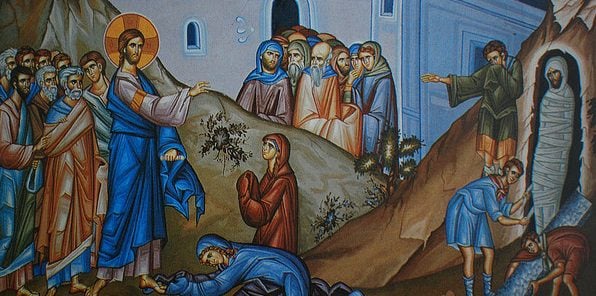
Pastors have a frequent question when they begin to discover mimetic theory. “That’s great. But how does it preach?”
Reverend Tom Truby show that mimetic theory is a powerful tool that enables pastors to preach the Gospel in a way that is meaningful and refreshing to the modern world. Each Wednesday, Teaching Nonviolent Atonement will highlight Tom’s sermons as an example of preaching the Gospel through mimetic theory.
In this sermon, Tom explores the death and raising of Lazarus to show that we don’t have to fear death. Indeed, Jesus came to free us from the fear of death, so that we might truly live. As Tom states, “Jesus, not formed by our reality, distorted as it is by our fear of death, a fear that permeates everything, knows that God is a God of life.”
All Saints Sunday
November 1st, 2015
Thomas L. Truby
Gospel of John 11:32-44
Four Questions
“When Jesus saw her (Mary) crying and the Jews who had come with her crying also, he was deeply disturbed and troubled.” Three verses later the text says “Jesus was deeply disturbed again when he came to the tomb.” What was disturbing him? Something is going on?
Is he disturbed and agitated about his friend dying? We’ve already been told that when Jesus got the message from Mary and Martha he said “This illness does not lead to death; rather it is for God’s glory.” It has to be something else.
James Alison says the Gospels are really notes for telling a story, “Cliff Notes,” if you will. We are supposed to take them and slow them down and work with them until they interpret us. John tells his story so that we know how it ends as we begin it. In the verses just before the Gospel Jesus tells Martha, “I am the resurrection and the life. Those who believe in me, even though they die, will live.” “Do you believe this?” he asks Martha.
From the moment the story begins the Gospel writer wants us to discover that we are formed and upheld by the power of God. This is the reality that is coming toward us in Jesus and the story of Lazarus is going to confirm this. Using James Alison’s images, Jesus is the massive star that more and more fills our field of vision. This benevolent star is much bigger than our planet and grows to fill the cosmos. We are being drawn into his orbit. He is a powerful sustainer of life whose effervescence shapes us and pulls us away from our preoccupation with the black hole of death. As the axis of our being is tipped toward the source of love, we discover ourselves more and more living in joy. We don’t have to fear death because it is as easily brushed aside by God as sleepiness upon waking. This is the new reality into which we are being drawn. It feels too good to be true! Do we believe this?
If we have lost a parent or a child, a brother or sister, a friend or a life’s mate, they are not lost. They are part of the invisible cloud of witnesses that surrounds us and they can see what we can see only dimly, as through a mirror darkly. They can see that God is love and death has no power against God.
Jesus, not formed by our reality, distorted as it is by our fear of death, a fear that permeates everything, knows that God is a God of life. Jesus knows what God is like. As it says in the prologue to St. John’s gospel, Jesus has been with God from the beginning. Soon we will see confirmation of this when Jesus is raised from the dead.
We don’t have to be afraid that it all ends here. We still have a future. God has us in his orbit. We are his children and God will not let us go. We are already circling the giant star and have been grasped by its gravitational pull. Jesus has drawn us even when we didn’t know we needed to be drawn and actively push him away. Even our killing him didn’t stop him. Still he keeps coming with forgiveness, compassion and love.
Why then was Jesus agitated and disturbed when he saw Mary and the other mourners coming toward him? I think he was feeling the full depth of what he will have to do to get us to see the depth of his father’s love. John doesn’t have a Garden of Gethsemane story and this serves that purpose. Jesus is coming to terms with what he must do to heal the human species. To get us to see love he must show love by allowing us to do to him what we do to each other and then forgive us. Being fully human, he has to work that through and allow himself to be disturbed and agitated.
Mary’s wailing and the ritual wailing of her friends told Jesus she didn’t believe God assured Lazarus’ continuance. There is a deep part of her that thinks death is inescapable. But the truth is life is inescapable because God creates life and gives it as a gift. But tragically because we are so afraid of death, we kill, thinking it a hedge against death when no hedge is needed.
This week I have been disturbed and agitated. I have four sisters and three of them visited the fourth that lives in Arizona and suffers from traumatic brain injury and dementia. My three sisters were there to seek power of attorney, assess the situation, and provide care in the four days they had. They sent a picture and it shocked me. Knowing my sister’s history, the picture became a symbol for me of how many in the world are treated. She has only one eye, having been assaulted in the 80’s, and was looking at the camera with an expression that I experienced as despair and profound fear. It released a complex of emotions I still haven’t sorted.
The morning after I received the picture I went to the Bishop’s Symposium and found myself sitting with four pastors I did not know from Washington. We were asked to talk about our reaction to the content of our speaker’s message and he had been telling us about the value of small groups as a way of revitalizing the church. I decided to tell them why I was in such a somber mood and showed them the picture.
In my agitation I said until we have a gospel that addresses this we don’t have anything worth sharing. I told them, for me, this is a picture of humanity in the grip of death. They let me vent. One man briefly put his arm around my shoulder. It was just right.
My sister was born with severe dyslexia. She always acted differently and so was persecuted unmercifully by her peers and she was defenseless. Many years later, long after she grew up, one of her peers, knowing how her life was turning out, apologized to my parents for how they treated her.
She saw herself as a victim and in many ways she was. After the assault in the 80’s she moved to Arizona where her situation gradually deteriorated to the point where she couldn’t see because she had no glasses, she couldn’t hear because she had no hearing aid, she couldn’t walk or use a wheel chair for fear she would fall and her mind had become paranoid and undependable. She is in an institution that keeps her alive physically but most of her has died and her losses are largely irreversible. Is there any hope for her? Any Good News that can cheer her life and hearten our own?
When Martha objected to Jesus’ opening the tomb he replied “Did I not tell you that if you believed, you would see the glory of God?” Martha clearly didn’t believe but still it happened. Effervescent life isn’t based on Martha’s belief. It’s based on God’s desire that Lazarus, my sister, you and I and the one’s we’ve lost, all continue but with new and resurrected bodies.
“So they took away the stone. And Jesus looked upward and said, ‘Father, I thank you for having heard me. When he had said this, he cried with a loud voice, ‘Lazarus, come out!’ The dead man came out, his hands and feet bound with strips of cloth, and his face wrapped in a cloth. Jesus said to them, ‘Unbind him, and let him go.’”
We have been unbound. The fear of death no longer constrains us. We are free to enter into our lives with the same kind of effervescence and joy we feel when we discover our resurrected Lord goes ahead of us.
So I ask four questions. Is death inevitable? No! It doesn’t even exist for God. Is life inevitable? “Yes! It is, it’s a given.” Is that Good News? It’s wonderful news! Does that change anything? It changes everything! Thanks be to God. Amen.











